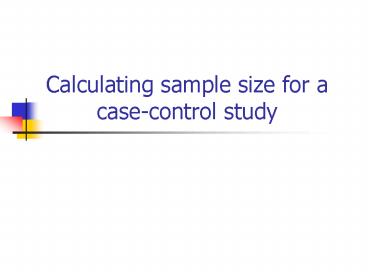Calculating sample size for a case-control study - PowerPoint PPT Presentation
Title:
Calculating sample size for a case-control study
Description:
Calculating sample size for a case-control study Statistical Power Statistical power is the probability of finding an effect if it s real. Factors Affecting Power 1. – PowerPoint PPT presentation
Number of Views:170
Avg rating:3.0/5.0
Title: Calculating sample size for a case-control study
1
Calculating sample size for a case-control study
2
Statistical Power
- Statistical power is the probability of finding
an effect if its real.
3
Factors Affecting Power
- 1. Size of the effect
- 2. Standard deviation of the characteristic
- 3. Bigger sample size
- 4. Significance level desired
4
Sample size calculations
- Based on these elements, you can write a formal
mathematical equation that relates power, sample
size, effect size, standard deviation, and
significance level.
5
Calculating sample size for a case-control study
binary exposure
- Use difference in proportions formula
6
formula for difference in proportions
7
Example
- How many cases and controls do you need assuming
- 80 power
- You want to detect an odds ratio of 2.0 or
greater - An equal number of cases and controls (r1)
- The proportion exposed in the control group is 20
8
Example, continued
- For 80 power, Z?.84
- For 0.05 significance level, Z?1.96
- r1 (equal number of cases and controls)
- The proportion exposed in the control group is
20 - To get proportion of cases exposed
- Average proportion exposed (.33.20)/2.265
9
Example, continued
- Therefore, n362 (181 cases, 181 controls)
10
Calculating sample size for a case-control study
continuous exposure
- Use difference in means formula
11
formula for difference in means
12
Example
- How many cases and controls do you need assuming
- 80 power
- The standard deviation of the characteristic you
are comparing is 10.0 - You want to detect a difference in your
characteristic of 5.0 (one half standard
deviation) - An equal number of cases and controls (r1)
13
Example, continued
- For 80 power, Z?.84
- For 0.05 significance level, Z?1.96
- r1 (equal number of cases and controls)
- ?10.0
- Difference 5.0
14
Example, continued
- Therefore, n126 (63 cases, 63 controls)































